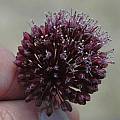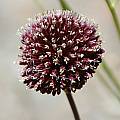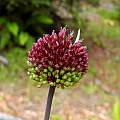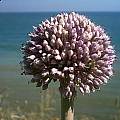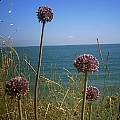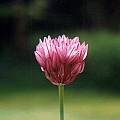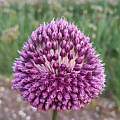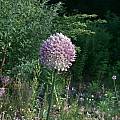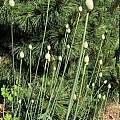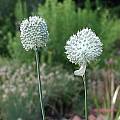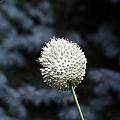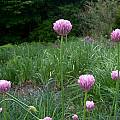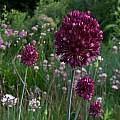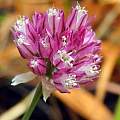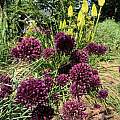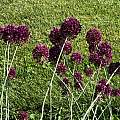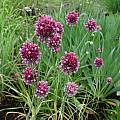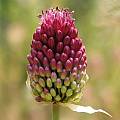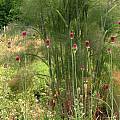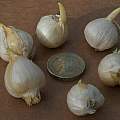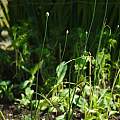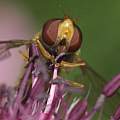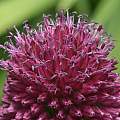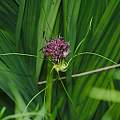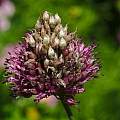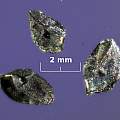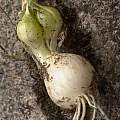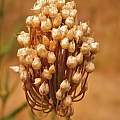The name Drumstick Allium aptly describes this group of onions having tall, thin stems, and tight knobs of bloom at the top, indeed looking like drumsticks. Onions in this group are primarily within Section Allium, the "type" section that defines the genus, although some onions in other sections may share the so-called "drumstick" appearance. Generally, all are easy in cultivation in full sun and ordinary well-drained loam or sandy soil.
Allium amethystinum Tausch is a species from the Mediterranean where it grows in rocky places. It has hollow leaves that have withered by flowering time (May to July) and many purple flowers in a spherical umbel. Photos by Bob Rutemoeller and Mary Sue Ittner.
Allium commutatum Guss. - A very late flowering allium for a Mediterranean plant, in bloom from July or later. This curious species grows on rocky slopes by the ocean and at the time of flowering is totally leafless. Bulbs are salt resistant and floaters, and they are dispersed during sea storms. Plants are found also growing deeply embedded in the pebbles of the beaches, haven fallen down from the slopes above. Photo in habitat by Angelo Porcelli
Allium griffithianum Boiss. - a beauty from C. Asia, with upright, flat-topped drumsticks of large carnous red-rose flowers, showing conspicuous dark red stripping. Allied to A. jacquemontii Kunth., Allium griffithianum only stayed with me a couple years, then succumbed (bulb rotted, I think). Photo by Mark McDonough.
Allium guttatum Steven has a wide distribution from the Ukraine to the Mediterranean. According to the Plants of the World Online there are five accepted subspecies. Photo by Wietse Mellema.
Allium guttatum ssp. dalmaticum (A.Kern. ex Janch.) Stearn is from Albania and W. Yugoslavia to E. Bulgaria, where it is considered endemic. This is a pink to purple color variant of Allium guttatum. It is nice, but not as attractive as the ssp. sardoum shown below. First photo by Mark McDonough, second by Rimmer de Vries.
Allium guttatum ssp. guttatum ranges from the Aegean region to Ukraine. It has whitish tepals blotched with purple
Allium guttatum ssp. kartalkayaense Yild. is native to Turkey.
Allium guttatum ssp. sardoum (Moris) Stearn is a fine European species from Portugal to Turkey, with dense heads of white flowers held precisely spaced, showing off bright white pedicels and small fluffy white florets stained with a small dark blotch on each tepal. The first photo was taken by Mark McDonough, July 18, 2002 and another view of this species is shown in the second photo of plants grown by Arnold Trachtenberg in New Jersey from bulbs purchased from Pacific Rim Native Plant Nursery.
Allium guttatum ssp. tenorei (Parl.) Soldano has a range from Tunisia to Libya.
Allium jacquemontii Kunth. - one of my absolute favorites, from C. Asia. Slow growing, and only mature bulbs flower, but a mature clump might produce a couple dozen tight knobs of fragrant luminous pink flowers. The heads widen and at full anthesis are a nearly flat-topped or domed drumstick. Flowers in June on 18" (45 cm) stems. Photo by Mark McDonough.
Allium rotundum L., syn. Allium scorodoprasum ssp. rotundum (L.) Stearn, is an Eurasian and North African species also naturalized in the United States (Michigan), the Canary Islands and South Australia. It grows to 18-24" (45-60 cm) tall, is slender of growth, and has tight oblong knobs of dark wine red-purple flowers. The first photo taken by Mark McDonough who wrote: "One of my favorites and easy to grow." The second photo from Mary Sue Ittner.
Photos by Rimmer de Vries, who comments 'I had two collections by Kirk Vickory in my garden a short 18” form and a taller 24” form they may have gotten mixed up. These made much smaller 1-1-1/2” heads in sand in Michigan, here in Kentucky heat and red clay they make large 2-1/2-3” heads'
Allium scorodoprasum L. is a European species with bulbils and is therefore to be avoided. It has purple flowers on unequal stalks.
Allium scorodoprasum ssp. jajlae (Vved.) Stearn is considered by Plants of the World Online to be a synonym of Allium rotundum L. It is another Mediterranean species, but without bulbils and grows 18"-24" (45-60 cm) tall or taller. Growth is slender, with leaves easily mistaken for grass, and it has showy oblong heads of bright raspberry rose and orchid florets. Photo by Mark McDonough.
Allium scorodoprasum ssp. rotundum see Allium rotundum
Allium sphaerocephalon L. syn. Allium sphearocephalum, also called "round headed garlic" (sphaero = sphere, cephalum = related to the head) is an easy to grow onion that produces very dramatic flowering heads in early summer. It is grown in many climatic regions in the United States including the Deep South. It is frost hardy, drought tolerant, best grown in full sun and well drained, fertile soil with extra lime. The species can be propagated vegetatively by bulbs and bulbils. A single bulb produces about 4 bulbils at the end of the growing season in early summer. The first two photos below were taken by Nhu Nguyen; the remaining photos were taken by David Pilling (the coin is about an inch in diameter). The last shows that the flowers do not open widely when the style and stamens appear.
Photo 1 shows a flower that was covered by foliage from nearby plants, and produced bulbils instead of a full flower. Photo 2 shows pollinated flowers forming seed pods. Photo 3 is of seed. Photo 4 is of a bulb accidentally uprooted whilst still growing, showing bulblet formation just below the surface (the stem is visible to the top left).
Photo below of the ripening seed pods by Travis Owen.
Allium index -All alliums - Allium flavum Relatives - American alliums A-F - American alliums G-Z - Big Ball alliums - Blue alliums - Chives - Domed alliums - Drumstick alliums - Rhizomatous alliums
